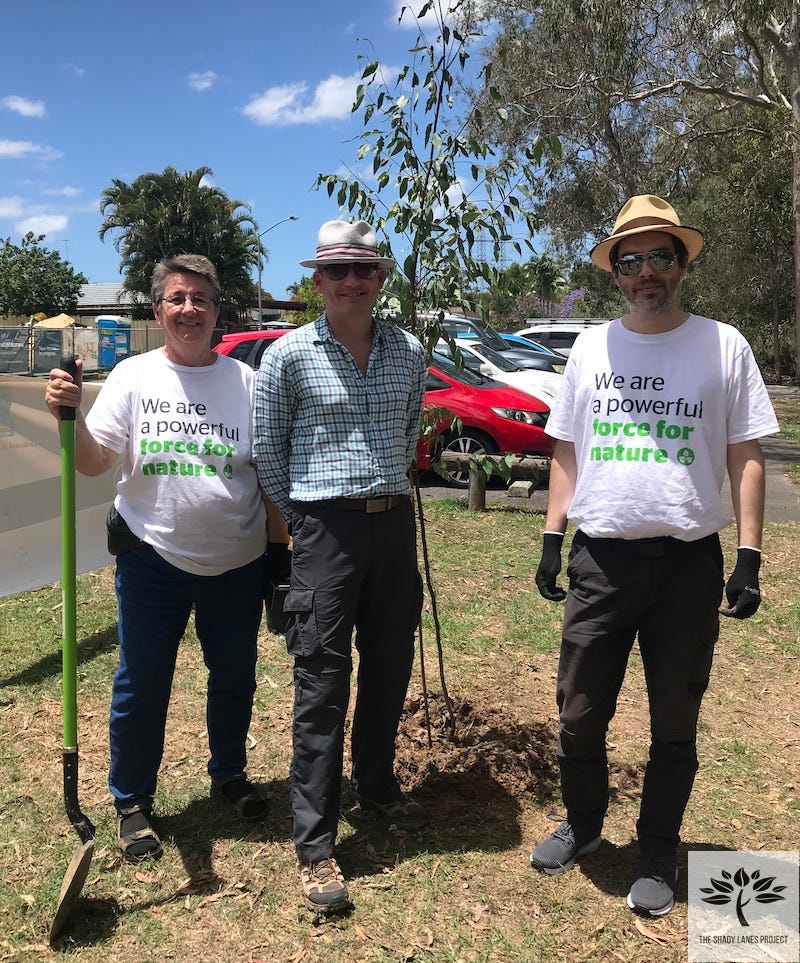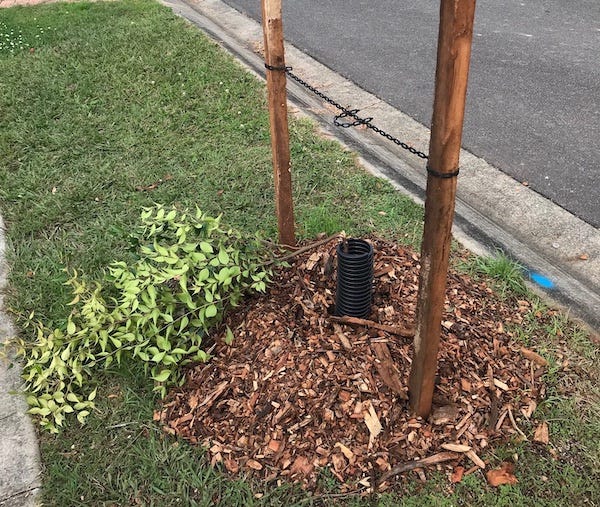Make Friends with your Council
Your first ally has to be the people working in your Council. Find out what they are trying to do and work out how that aligns with your goals.
On Saturday, we went to a council street tree planting. The council invited us to have a stall to promote the Shady Lanes way of planting native verge gardens around their street trees, reinforcing the message to comply with council guidelines.
For me and my local ACF Community group, it’s an easy task because Council does all the setup. I just take along my display and talk and listen to the public, council officers, and other stall holders.
These are friendly events where we all have a common purpose - to green our city for shade, biodiversity, and habitat, AND to bring the public along with us.
Every verge garden is a simple collaboration between
the council, the resident, and nature.
The council provides the street tree and policy. The resident provides the garden. Nature does the hard work of regenerating. Working together we can do more than any of us can do alone. The better we work together, the better the outcomes.
Council
Councils around Australia need to increase tree canopy throughout our cities to help reduce urban heat. They have qualified arborists who keep up with research on which trees are most likely to cope with changes to climate. It makes sense that councils provide and maintain the street trees. And you shouldn’t blame today’s arborists for decisions made by other people decades ago.
Council staff are also accustomed to seeing the verge from an overall viewpoint - as a part of the much larger city landscape and urban forest, and a place of many uses and users. They have to liaise with all the other stakeholders and service providers. They know the laws and standards and requirements for pedestrian access, traffic safety, and so on. Part of their job is to minimise risk, so your rates money doesn’t pay for some other verge gardener being careless or negligent. Their knowledge and experience all feeds into the council verge garden policy.
Residents
Residents are the best people to provide the understory for many reasons: the verge is right where they live; their focus is on their verge and their street. This is the only way we are going to be able to afford planting and maintenance on the scale we need to help address urban heat and biodiversity loss. The Understanding the Space articles and these newsletters are there to help residents avoid pitfalls and get the most out of their verge garden.
As well as helping the street trees thrive, our verge gardens bring biodiversity into the everyday life of our communities. They help other residents get to know and appreciate our native plants and understand that natural biodiversity is more than green lawn, trees and food growing.
Nature
Working with nature, using local native plants, no herbicides and pesticides, and choosing plants that suit the soil and conditions for incremental change, gives nature the best start to regenerate habitat for all our flora and fauna.
When we all work in the same direction, we make more progress and faster progress. We could transform our cities very quickly if we all just set to and got on with it.
If only it was that easy
Councils have to contend with a surprising number of residents who refuse to have new street trees and damage existing trees. And those residents are unlikely to be interested in planting their verge either.
Within your council, there will be a mix of people who want verge gardens and those who don’t. Different council departments have different priorities and must compete for resources - planting versus roads and other services. Many oppose verge gardens because they don’t trust residents to plant sensibly, sometimes with good reason. Councillors have different roles and priorities to council staff.
Residents can help verge garden advocates within councils by showing that residents can be trusted to do the right thing and stay within council policy and guidelines. Every verge garden dispute sets everyone back.
For residents of councils with no policy or with extremely restrictive policies, you need to play the long game of working with your allies within councils with a spirit of advocacy and co-operation, not conflict or protest. Remember, the many benefits of verge gardening mean your allies could be in many different departments.
Resident verge gardeners also have a role to play in providing positive examples, and convincing neighbours and other members of the public to accept native verge gardens or even plant their own. The Understanding the Space articles will give you tips on this.
How do we get more people to act?
We have organisations and Facebook groups spreading the word about planting for biodiversity inside the garden and on the verge. We put in plenty of time and effort. Everyone agrees that it’s a good thing. But eventually we realise we are only speaking to the converted.
This is the challenge I’ve been working on with Shady Lanes, testing and refining ideas during the Banyo Pilot project. Now we’re gaining traction engaging with likely and unlikely allies.
It needs a loose network of people and groups with their own reasons to work towards a shared purpose. The number of competing users and uses in this space is why verges offer so much opportunity - and why it needs that initial collaboration between council, resident, and nature at its core.
We draw in people and groups and organisations who want action on active transport, physical and mental health, community building, communal greenspace for increasing urban density, shade to tackle urban heat, increasing biodiversity for climate change, and so on.
We don’t need them to share our reasons or put our priorities ahead of theirs. Everyone is working towards that shared purpose (to green our city for shade, biodiversity, and habitat AND to bring the public along with us) AND their own goals.
Every participant brings with them more resources, more knowledge, more ideas, and more energy. It is more like an ecosystem of people than a hierarchy or single-interest groups acting alone.
It’s a different perspective, but as gardeners we already understand the concept of ecosystems and how they start with small incremental steps and every new participant adds to the overall value and possibilities.
The Keep Sandgate Beautiful Association has come into our network and is starting a group verge garden project with their members.
Having the resources of a local network means their members could go to a working bee at the nearby Banyo group (Facebook story) to get ideas and talk to the Banyo gardeners about their experiences.
One of their members has done an introductory video (Facebook or YouTube) on my verge to promote their project and draw more interest in their community.
In December, we’ll be having a joint information meeting co-hosted by ACF Brisbane Community Brisbane Northside, Banyo Verge Gardeners, Keep Sandgate Beautiful, and Shady Lanes. That means a lot less work for each group and a much greater reach. It’s also a sharp learning curve for them because this is a different way of planning and working.
Likely and Unlikely Allies
In my experience, the most obvious allies often don’t see what your idea has to do with them or how it could benefit them. Sometimes, they see you as competing for members, grants, or resources.
Unlikely allies can be more productive at pooling resources for a shared solution. Look at other networks for ideas, talk to your contacts to see if they have contacts in your area.
Your most important allies are the people working in your Council. Go to their events and stalls where they try to get the community engaged. Find out what they are trying to do and work out how that aligns with your goals.
Who might you draw into your network? What value could you add to an existing network?
Manage your subscription and emails
You can manage your subscription and which emails you receive in your account settings. Find out more about on the About page.






It would be useful, I think, to have a match making function, as long as access is easy. I'm still learning about substack).
Next year I will be working more on connections with council and locals, so maybe I will need a dedicated posting area or Facebook group. What would be your suggestion? cheers.
Thanks again for an encouraging editorial. I have been dithering about contacting my local Council in East Gippsland to try and get some involvement with spreading the idea of verge gardening and involving more residents then groups later.
The council is already preparing a Verge Garden Policy or statement , for release in 2024. I would like to see it released as a bit of a publicity event for the idea and to form some informal local networks.
However I keep thinking this is a bit 'pushy' and am putting off the moment to take action!! As I said in my intro when I joined the group, I tend to rush into projects, then keep second guessing myself.
However, I see from Gayle's post that is it an effective pathway, so will start writing the letter today. Fingers crossed for a positive response.